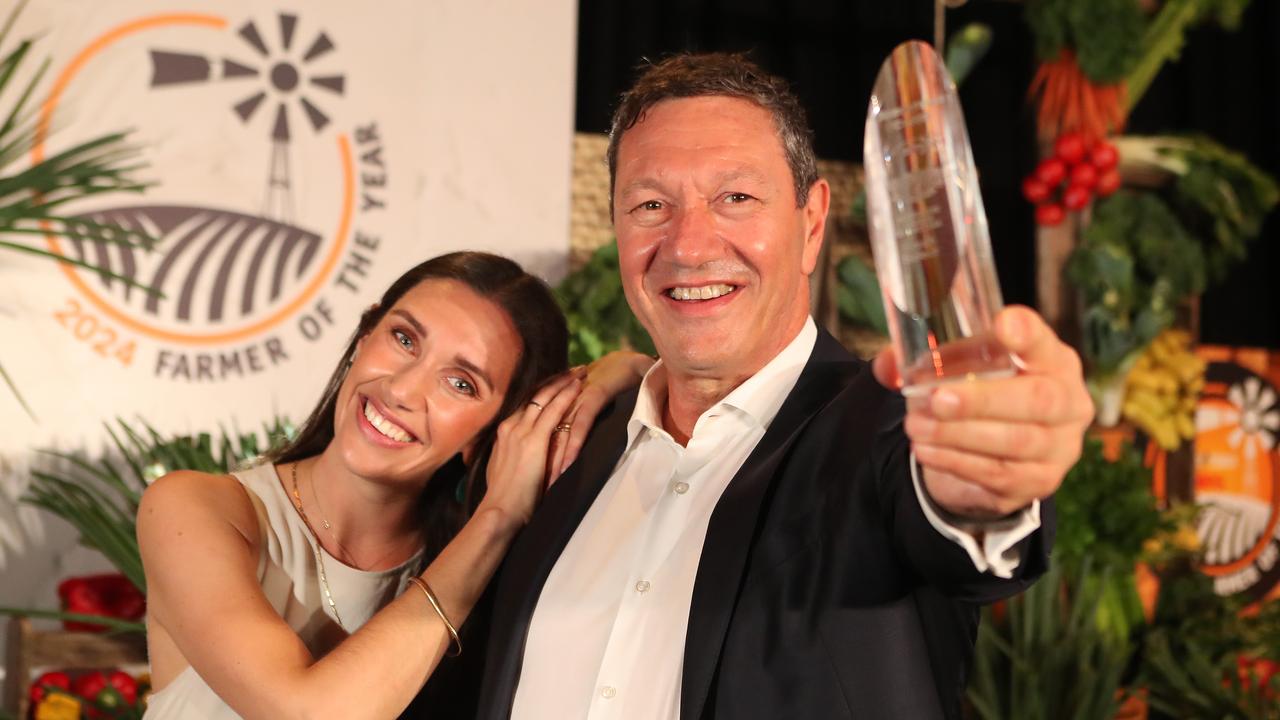Ian Farley of Marmon Hill at Jabuk tops the chops
Few know the secret to successfully breeding prized first-cross ewes better than South Australia’s Ian Farley. And here he shares what he knows and how he got there.
SOUTH Australian mixed farmer Ian Farley might not think he’s doing anything special, yet his results are first class.
A regular vendor at the Naracoorte first-cross sales, the sheep from Marmon Hill at Jabuk always figure at or near the top of the sale results.
They have also won best-presented pen twice, in 2009 and 2016.
Yet it is the average prices they are more satisfied with, especially when they are one of the major vendors at the famed spring sales.
Three years ago, the top price at the Naracoorte first-cross sale was $326.
At the same sale, Marmon Hill didn’t quite reach that level but impressively still averaged $266 for 2400 ewe lambs.
It’s this kind of result that shows the depth of breeding in the Marmon Hill flock according to Ian, who has been producing first-cross ewes for 38 years.
It’s not an industry for the faint hearted — the cyclical nature means that sometimes first-cross ewe prices are similar to wether rates, and meat buyers have purchased runs of future breeders to kill.
But there has been a steady increase in prices since 2012, which have climbed gradually over the years. At the same time, the repeat customer base for the Marmon Hill ewes has grown too.
The Farleys have stuck with first-cross ewe production and are now reaping the rewards of a program dedicated to selling the best first-cross ewe lambs and one-and-a-half-year-olds each spring.
NOW ‘EAR THIS
WANTING to be near the top of the market requires two things — the right kind of Border Leicester ram and the right type of Merino ewe.
Ian said they were very particular in both sides of the breeding equation when selecting genetics.
“You want length in your Merino ewes, so we look for the bigger, Mallee-bred Merino ewes, and ideally try to buy from dispersal sales,” he said.
He searches for certain bloodlines that are known for their thick skin, and Ian does something that many looking for stock might not do — he feels the sheep’s ears.
“The thickness in the ears is indicative of a good sheep,” he said.
Length is also a key criterion in the rams he buys, most of which have come from the Inverbrackie stud at Strathalbyn as well as some from the Coolawang Border Leicester stud at Mundulla in the past two years.
“If you have a longer sheep, then the processors can get another four chops from the progeny and so they look for the longer-bodied lambs,” he said.
Ian considers the figures of the rams and will only buy new sires if they have low birthweight numbers, but prefers to use his eyes to look at the sheep rather than the catalogue for other selection criteria.
“Yes, I do look at figures but there is no emphasis on them particularly,” Ian said.
“I like a Border Leicester ram with tight, curly wool and there’s a good reason for that — it results in wether lambs that look fresher for longer.
“While we breed first-cross ewes and sell them, the wether portion is also important especially as we try to sell them all in wool as suckers.”
LAMBING GOALS
THE Marmon Hill flock has two lambings for first-cross ewes — one in March-April and the other in June-July in the 400mm rainfall country.
That rain has been less than consistent in the past few years, with most annual tallies just 200-300mm — even still, there’s been enough rain to grow feed to consistently turn off high quality first-cross ewe lambs and ewes.
The progeny of the earlier lambing is sold as first-cross ewe lambs in the spring sales at Naracoorte, and to be big enough to attract high prices, must be well grown, mature and well prepared.
“The ewe lambs are about 65kg at seven months old with the top draft 65-70kg,” Ian said. “Buyers want to be able to take those ewe lambs home, join them in a few weeks and get a really good lambing percentage.”
The second lambing, in winter, allows that drop to go onto spring feed, then grow out and be sold the following year as 1-1/2-year-olds in another Naracoorte first-cross fixture.
Here the Marmon Hill sheep also star in the best price bracket including posting an average of $329 for its draft in 2017.
About 6000 Merino ewes are joined for first-cross production while another 2000 Merino ewes are joined to White Suffolks and lamb down in March/April to take advantage of spring feed and target the early lamb market.
SHED START
THE rise of the Marmon Hill enterprise has come off the back of a lot of hard work by Ian and his family.
A career in the shearing sheds (roustabout and wool pressing) led Ian to make the unlikely purchase of a small almond block.
That block became two when he bought another, then at 24, he sold those to buy his first broadacre farm of 1000ha. Yet his hankering was always to be involved in the first-cross ewe industry, following on from his father who used to buy in ewe lambs and then grow them out to 1-and a half-year-olds.
Now the Marmon Hill progeny have earned a reputation across South Australia’s South East and into Victoria for quality and prime lamb dam performance.
Ian said he was noticing a swing back to the traditional first-cross ewe in lamb operations, after some may have dabbled in running composites. “A first-cross ewe produces a magnificent second-cross lamb,” he said.
“We are getting better and better at selecting the right genetics and the quality of what we are producing is getting better too.”
Management of the flock is also getting better, he said, especially in terms of lambing down ewes. Despite dovetailing the first-cross operation in with the cropping program, the ewes are still lambed down in small mob sizes of about 100 in large paddocks.
This, he said, had definitely helped with lamb survival.
SHEEP FIRST
WHILE the ewe progeny might get the ribbons and the publicity, the wether portion of the first-cross operation is still well and truly making its mark on the bottom line.
Most of the 2500 first-cross wether lambs are sold privately to either JBS Australia or Thomas Foods International at about 50kg liveweight.
With some carcasses yielding 50 per cent, the first-cross wether suckers are killing out with a 25kg carcass.
If prices slip, as they did this spring, some of the younger wether lambs are retained, shorn and will be sold into the old lamb market.
With an extensive cropping program, including one third legumes and two-thirds cereals spread over hundreds of hectares, the inclusion of sheep makes for a busy operation.
But Ian maintains that he is a sheep farmer that grows a few crops rather than the other way around.
“We need the stubbles to graze the sheep on over summer, and we drench them before they go onto the stubbles each year,” he said.
“Certainly, I would say I am a sheep producer first, and then a cropper.
“The agent was out one day, and my son said to him, ‘I think dad loves his sheep more than his kids’ — and he could be right.”


